[English] 日本語
 Yorodumi
Yorodumi- PDB-9b4j: Filament of D-TLKIVWS, a D-peptide that disaggregates Alzheimer's... -
+ Open data
Open data
- Basic information
Basic information
| Entry | Database: PDB / ID: 9b4j | ||||||||||||
|---|---|---|---|---|---|---|---|---|---|---|---|---|---|
| Title | Filament of D-TLKIVWS, a D-peptide that disaggregates Alzheimer's Paired Helical Filaments, determined by Cryo-EM | ||||||||||||
 Components Components | DTH-DLE-DLY-DIL-DVA-DTR-DSN | ||||||||||||
 Keywords Keywords | UNKNOWN FUNCTION / Alzheimer's disease / Tau / fibril / cryo-EM / helix | ||||||||||||
| Function / homology | polypeptide(D) Function and homology information Function and homology information | ||||||||||||
| Biological species | synthetic construct (others) | ||||||||||||
| Method | ELECTRON MICROSCOPY / helical reconstruction / cryo EM / Resolution: 3.5 Å | ||||||||||||
 Authors Authors | Hou, K. / Ge, P. / Sawaya, M.R. / Eisenberg, D.S. | ||||||||||||
| Funding support |  United States, 3items United States, 3items
| ||||||||||||
 Citation Citation |  Journal: Nature / Year: 2025 Journal: Nature / Year: 2025Title: How short peptides disassemble tau fibrils in Alzheimer's disease Authors: Hou, K. / Ge, P. / Sawaya, M.R. / Lutter, L. / Dolinsky, J.L. / Yang, Y. / Jiang, Y.X. / Boyer, D.R. / Cheng, X. / Pi, J. / Zhang, J. / Lu, J. / Abskharon, R. / Yang, S. / Yu, Z. / Feigon, J. / Eisenberg, D.S. | ||||||||||||
| History |
|
- Structure visualization
Structure visualization
| Structure viewer | Molecule:  Molmil Molmil Jmol/JSmol Jmol/JSmol |
|---|
- Downloads & links
Downloads & links
- Download
Download
| PDBx/mmCIF format |  9b4j.cif.gz 9b4j.cif.gz | 86.7 KB | Display |  PDBx/mmCIF format PDBx/mmCIF format |
|---|---|---|---|---|
| PDB format |  pdb9b4j.ent.gz pdb9b4j.ent.gz | 93.7 KB | Display |  PDB format PDB format |
| PDBx/mmJSON format |  9b4j.json.gz 9b4j.json.gz | Tree view |  PDBx/mmJSON format PDBx/mmJSON format | |
| Others |  Other downloads Other downloads |
-Validation report
| Summary document |  9b4j_validation.pdf.gz 9b4j_validation.pdf.gz | 1 MB | Display |  wwPDB validaton report wwPDB validaton report |
|---|---|---|---|---|
| Full document |  9b4j_full_validation.pdf.gz 9b4j_full_validation.pdf.gz | 1 MB | Display | |
| Data in XML |  9b4j_validation.xml.gz 9b4j_validation.xml.gz | 30.7 KB | Display | |
| Data in CIF |  9b4j_validation.cif.gz 9b4j_validation.cif.gz | 42.5 KB | Display | |
| Arichive directory |  https://data.pdbj.org/pub/pdb/validation_reports/b4/9b4j https://data.pdbj.org/pub/pdb/validation_reports/b4/9b4j ftp://data.pdbj.org/pub/pdb/validation_reports/b4/9b4j ftp://data.pdbj.org/pub/pdb/validation_reports/b4/9b4j | HTTPS FTP |
-Related structure data
| Related structure data |  44182MC 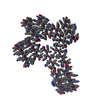 9b4iC 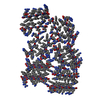 9b4kC 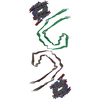 9b4lC 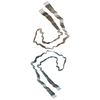 9b4mC  9b4nC  9b4oC C: citing same article ( M: map data used to model this data |
|---|---|
| Similar structure data | Similarity search - Function & homology  F&H Search F&H Search |
- Links
Links
- Assembly
Assembly
| Deposited unit | 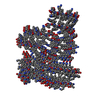
|
|---|---|
| 1 |
|
- Components
Components
| #1: Polypeptide(D) | Mass: 846.026 Da / Num. of mol.: 60 / Source method: obtained synthetically / Source: (synth.) synthetic construct (others) Has ligand of interest | N | Has protein modification | N | |
|---|
-Experimental details
-Experiment
| Experiment | Method: ELECTRON MICROSCOPY |
|---|---|
| EM experiment | Aggregation state: FILAMENT / 3D reconstruction method: helical reconstruction |
- Sample preparation
Sample preparation
| Component | Name: D-peptide TLKIVWS / Type: COMPLEX / Entity ID: all / Source: SYNTHETIC |
|---|---|
| Molecular weight | Experimental value: NO |
| Source (natural) | Organism: synthetic construct (others) |
| Buffer solution | pH: 9.07 / Details: Dissolved in de-ionized water |
| Specimen | Conc.: 10 mg/ml / Embedding applied: NO / Shadowing applied: NO / Staining applied: NO / Vitrification applied: YES |
| Specimen support | Grid material: COPPER / Grid mesh size: 300 divisions/in. / Grid type: Quantifoil R1.2/1.3 |
| Vitrification | Instrument: FEI VITROBOT MARK IV / Cryogen name: ETHANE / Humidity: 100 % / Chamber temperature: 295 K |
- Electron microscopy imaging
Electron microscopy imaging
| Experimental equipment |  Model: Titan Krios / Image courtesy: FEI Company |
|---|---|
| Microscopy | Model: FEI TITAN KRIOS |
| Electron gun | Electron source:  FIELD EMISSION GUN / Accelerating voltage: 300 kV / Illumination mode: FLOOD BEAM FIELD EMISSION GUN / Accelerating voltage: 300 kV / Illumination mode: FLOOD BEAM |
| Electron lens | Mode: BRIGHT FIELD / Nominal magnification: 81000 X / Nominal defocus max: 2500 nm / Nominal defocus min: 1800 nm / Cs: 2.7 mm / Alignment procedure: COMA FREE |
| Specimen holder | Cryogen: NITROGEN / Specimen holder model: FEI TITAN KRIOS AUTOGRID HOLDER |
| Image recording | Electron dose: 50 e/Å2 / Film or detector model: GATAN K3 BIOQUANTUM (6k x 4k) |
- Processing
Processing
| EM software |
| ||||||||||||||||||||||||||||||||
|---|---|---|---|---|---|---|---|---|---|---|---|---|---|---|---|---|---|---|---|---|---|---|---|---|---|---|---|---|---|---|---|---|---|
| CTF correction | Type: PHASE FLIPPING AND AMPLITUDE CORRECTION | ||||||||||||||||||||||||||||||||
| Helical symmerty | Angular rotation/subunit: 3.509 ° / Axial rise/subunit: 9.558 Å / Axial symmetry: C1 | ||||||||||||||||||||||||||||||||
| Particle selection | Num. of particles selected: 454000 | ||||||||||||||||||||||||||||||||
| 3D reconstruction | Resolution: 3.5 Å / Resolution method: FSC 0.143 CUT-OFF / Num. of particles: 32435 / Symmetry type: HELICAL | ||||||||||||||||||||||||||||||||
| Atomic model building | Protocol: AB INITIO MODEL / Space: REAL | ||||||||||||||||||||||||||||||||
| Refine LS restraints |
|
 Movie
Movie Controller
Controller








 PDBj
PDBj